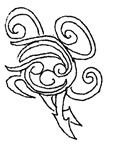Adam Blatner
Words and Images from the Mind of Adam Blatner
Dance of the Diddly-doodles on Arabesque Day
Originally posted on July 25, 2013
Below is a picture of a diddly-doodle, rendered sort of anthropo-morphically. (We’ve found that humans can relate better to that which they can relate to more.)
Diddly-doodles live in another dimension where they elaborate flowery complexities in the cosmos: this is their “job.” It is needed, else everything be square and orderly. Mussed-up hair, charming if you open to it, tends to get combed into “order.” Admittedly, there is a place and time for order, but not always. The diddly-doodles here demonstrate both spontaneity, disorder, individuality, and yet aesthetic harmony.
Sometimes, as is the wont of everything, they get together and do more collaborative projects. Indeed, this activity of their has helped to construct the universe we live in, a universe that mixes both disorder and order. But sometimes, just for fun, they create wondrous structures, as they do (shown below) on (loosely translated) “Arabesque Day,” when they gather and doodle-dance both freely and yet generate a kind of order amidst the disorder. 
Here is their dance. What you see is a 2-D spatial configuration that in transdimensional reality is far more elaborate and vast in this universe, though a “local” occurrence in a higher universe. On this special occasion which we will call “Arabesque Day,” a goodly number of diddly-doodles gather and co-create a dance that orchestrates the dancing moves of all their component becomings. (I use the word “becoming” rather than “being” because in other universes our becoming-ness is more obvious to them. In our world, as perceived by most human minds, things are imagined as static, “being,” nouns. A few deeper thinkers such as Heraclitus in ancient Greece or Whitehead almost a century ago noticed that everything is not thing-ish so much as ever-newly-becoming-ish, which is why Whitehead’s later philosophy is called “process philosophy.”) Anyway, back to the dance: Note in this dance of the diddly-doodles on Arabesque Day that there are several orders of harmonizing.
As for the word “doodle”: To “doodle” in our world, is to allow the angel-ettes of spontaneity to move the pen. The activity seems to most humans (who over-value solidity and definition) to be a trivial enterprise. In other realms where process is more valued, doodling is in turn recognized as opening to the multi-dimensional influences of spontaneity. It becomes liberated from fixity.
To say again: Humans express doodling mainly through their hands with marking instruments, but the diddly-doodles dance it with their whole bodies. (Admittedly, some humans also dance spontaneously, and sing, and in other ways also free their spirit.) This liberation activity—which seems to us in our cosmos as mere doodling—in other universes is recognized as enacting the aesthetic permutations of free minds!

Leave a Reply